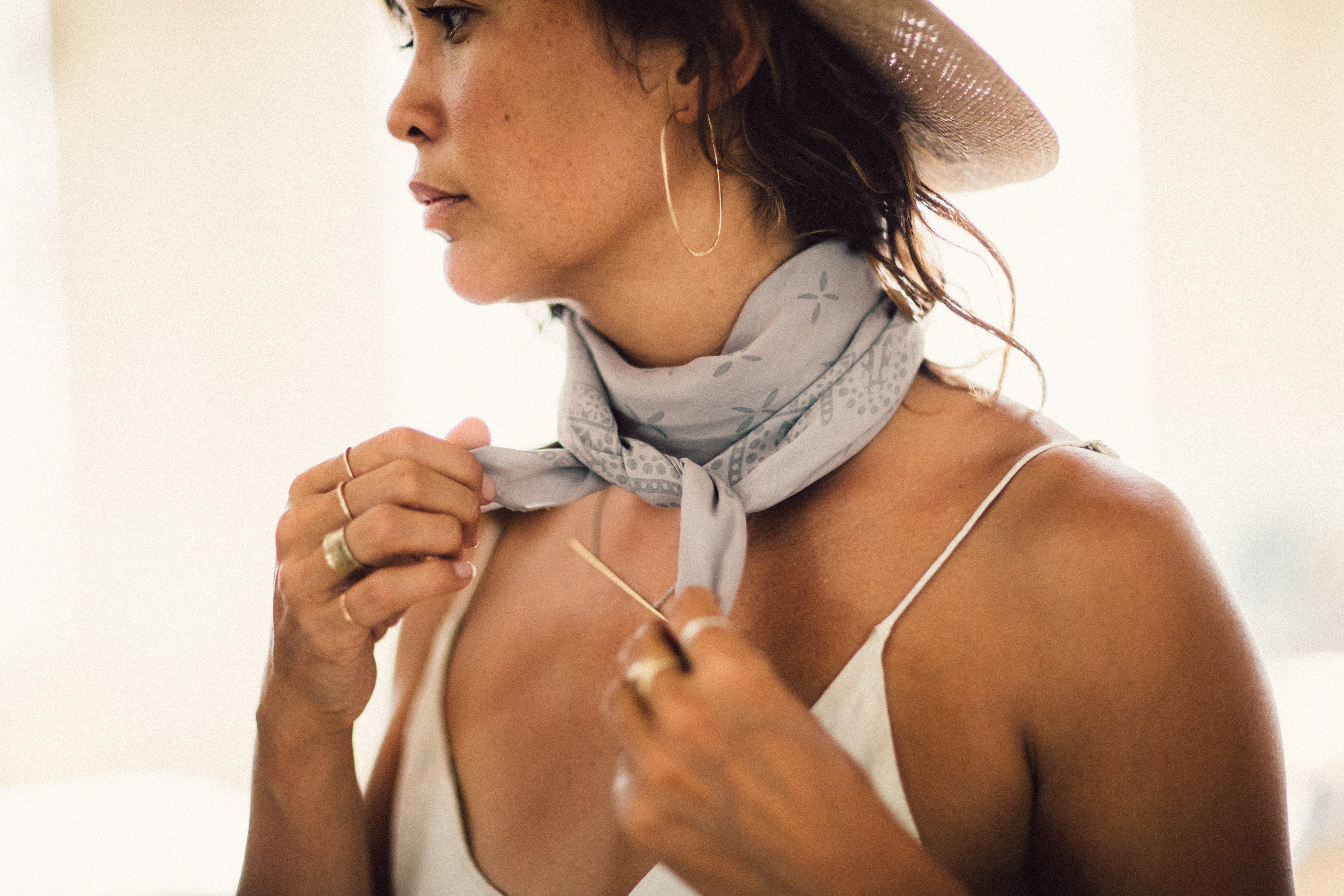
THE 1930s BANDANA, Conch, Fog, Sand
Have you ever found yourself in a vintage store, rummaging through that bewitching giant basket of scarves?
I always found myself digging through those endless piles, falling head-over-heels for the different interpretations. Composed of paisley, equestrian, or nautical themes, the designs were more than decoration. They were timestamps of not only a certain moment in fashion, but in culture too and that’s what really wooed me. Could scarves be the perfect simple object? My perfect match? A square swath of fabric, elevated through meaningful mark making, and steeped in utility. That’s how my love story with scarves began, though the story of scarves dates back much further than my vintage store rendezvous.
Scarves made their evocative place in our lives thanks to their ancestor the bandana, which has been a wearable staple for well over 200 years, and has taken on just as many guises. While inspired by kerchiefs (the original ancestor), the modern bandana hails from around 1780 after America had won its independence, and a printmaker named John Hewson created the “first” bandana: an unflattering yet patriotic depiction of George Washington. From promoting political campaigns and patriotism to later promoting pop-culture like Elvis and advertising like Disney’s Snow White and the Kellogg’s brand, banadas have always been hard workers.The word itself is rooted in the Hindi 'bāṅdhnū' and in the Urdu 'bāndhnū' which translates to “a tied, bound cloth.
”A piece of fabric elevated to the most flexible object on the planet that can be both worn or put to good use? I was all-in.
There was one bandana in my life, a vintage 1930s scarf, which brought this romance to the next level.
You know, the level where I wanted to meet the bandana’s parents and start to make real commitments. But sometimes, great relationships just aren’t great enough. And while my vintage scarf was there for me in countless ways, I wanted more. When I sat down to create the first OZMA scarf, it was the 1930’s Bandana which I based on the iconic vintage scarf I came to love through my own obsession with how many uses it had!
Over the holidays a few years back, and in the very beginning days of OZMA, I took a girls’ surf trip in Baja.
We'd rented a beautifully-tiled and sunny house there, an idilic place to spend some gal pal time, stuff our faces with seafood and margaritas, and enjoy our lucky proximity to the sparkling, empty waves. In between sunrise sessions and afternoon tacos, I set to task on designing the OZMA 1930’s Bandana with it's original border detail to honor it's history. After adding a secondary border of petite dots, I created the center pattern featuring a hand-drawn iconic detail. I wanted it to feel more organic, but ambiguous, so I painted a simple symmetrical key shape: a cross that takes on a floral personality. The imperfect touch of drawing makes every OZMA scarf feel delicate and personal. And while the very first colorway I selected was hand-dyed indigo, the OZMA bandanas now come in an ever-evolving palette of earthy, versatile colors. I also stepped away from the traditional 20” x 20” bandana and chose a 29” x 29” square, to give this piece the oversized presence it deserves.

THE Dot Hankie

THE 1930s BANDANA, Cedar
When it came to the Dot Hankie, I chose a simple 17” x 17” silk square and set out to create the perfect, petite accent scarf to wear around your neck, wrapped in your hair, or simply styled in infinite ways. The OZMA dot hankie offers a softer approach to the classic because of the delicate imperfect drawn dots on powdery washed silk. They key shape is the dot, patterned into a border of alternating diamonds and lines, surrounded by a secondary border of equally sized and spaced dots, and at the center? An ever so slightly larger dot pattern, evenly dispersed. The design is an ethereal adaptation of traditional resist dye techniques of Turkey and India.
Hankies were first used in the East to protect people’s heads from the sun. Much later, during the American depression, a handkerchief was often the only new item a woman could afford enhance her wardrobe. A woman would change her outfit by changing her hankie. Also, they were often given as tokens of remembrance or gifts to loved ones, connecting loved ones to personal memories and emotions. Joining this rich history of meaning has made designing OZMA’s scarves both a humbling process and a grand dance. I’ve sourced the material for the 1930's Bandana and the Dot Hankie carefully; Our silk is luxe, but it’s machine washable and ok to tumble dry, which makes it memorable yet practical. OZMA scarves are authentic, but not precious. We handprint them with care locally in Los Angeles, selecting earthy colors that reflect nature and compliment everyone’s natural beauty. Making them a truly uncomplicated, yet magnetic piece that every woman can limitlessly style. Even if don't want to commit to an entirely new outfit, an OZMA bandana or hankie is an easy and fun styling piece.
Like any true love. Whether you tie them, knot them, or put them to work, the choreography of an OZMA scarf is always pure love.
